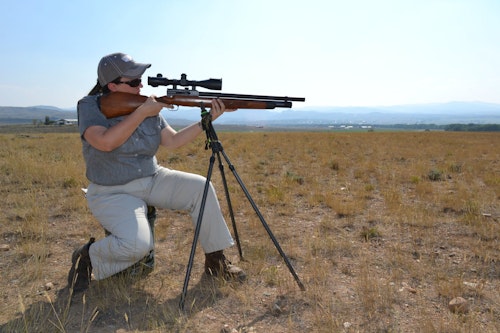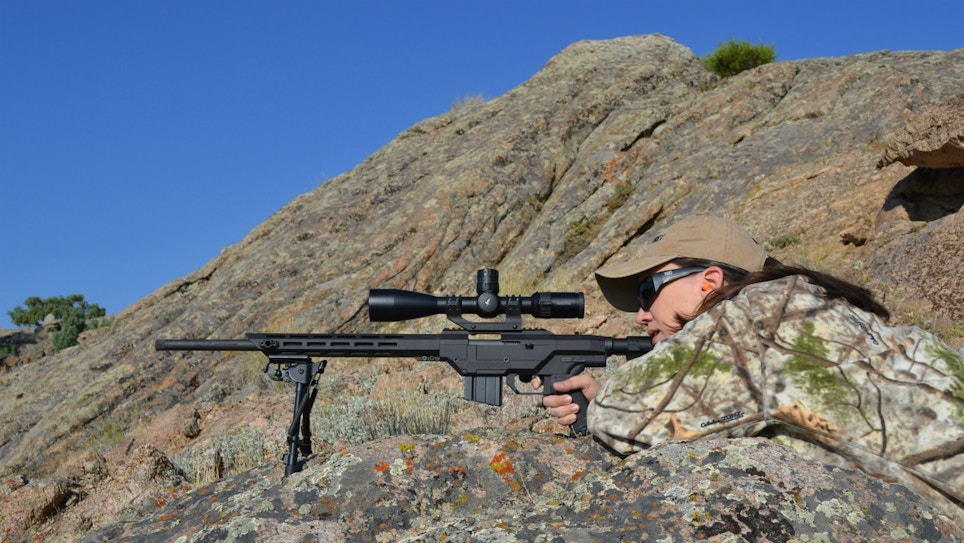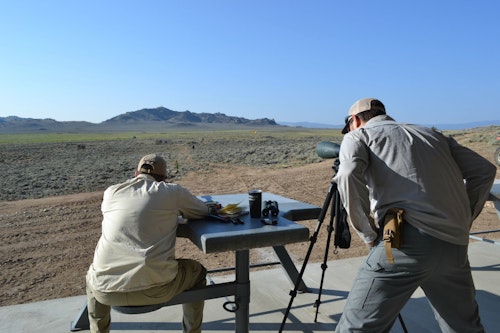Big game gets all the glory in hunting these days, but plenty of your customers are pursuing small game in their free time, or plinking at varmints all summer to keep themselves occupied and maybe protect their land, crops or gardens. And one of the most abundant (depending on the area) and fun varmints to hunt? Prairie dogs.
Non-hunters (and many times, even hunters) often ask why anyone would hunt prairie dogs. Well, for one thing, prairie dogs are an enemy of ranchers, destroying property and crippling cattle that step in their never-ending holes. That’s reason alone to terminate them with impunity. But for hunters, there’s another very good reason: A prairie dog hunt is a target-rich environment like no other, and it offers a chance to hone your skills in a short amount of time. A two-day prairie dog hunt will give you so many opportunities to practice gun handling, shooting from field positions, and even spotting and stalking that you’ll be a vastly improved hunter by the time you’re done.
Last August I spent two days chasing prairie dogs (and I do mean chasing) at the Spur Ranch in Wyoming. It was late in the season, so setting up on a bench over a prairie dog town wasn’t a productive option. Rather, we did spot-and-stalk hunting, some on foot and some with the aid of a truck on the ranch trails. But what made this hunt interesting was the dramatically different gear I used each day. If you’ve got customers who shoot prairie dogs or other small varmints, this is something to consider.
Airgun Style
We spent the morning at the range, shooting everything from airguns up to the 6.5 Creedmoor at ranges from 20 yards to one mile. When it came time for the afternoon prairie dog hunt, I knew what I wanted to do first: spot and stalk with an airgun.
I know, spot and stalk for prairie dogs sounds a little nuts, but believe me, it’s off-the-charts fun. I was relatively new to airguns, but fortunately, I was accompanied by Rick Eutsler, who’s among the country’s top airgun experts and an avid hunter, and Lawrence Taylor, who works for Gamo.
Given the range limitations on airguns, I asked Lawrence, why would anyone choose them for prairie dogs?
“There are a couple reasons for choosing an airgun over a firearm for prairie dogs or other varmints,” he told me. “One is upping the challenge. You need to cut the distance and shoot from closer ranges when using an airgun, but within effective ranges, air rifles are plenty accurate and powerful enough to do the job. It’s more like hunting than shooting, like choosing a bow over a rifle for deer hunting. Now, I know it’s a blast to sit back and pick off tiny targets at 200 yards, but this brings me to the next reason — cost. Burning ammo gets expensive quickly! With an airgun, your costs are reduced, because both the guns and especially the ammo are far more economical.”
With that in mind, and armed with a Winchester Air Rifles Model 70 in .35 caliber with a five-shot magazine, we spent the afternoon spotting prairie dogs and ground squirrels, getting as close as we could, setting up on sticks, and taking shots. The downside — or the fun side, depending on how techy you are — is that a PCP airgun like this one has to be refilled from a scuba tank or carbon fiber bottle every 10-12 shots (this was the rate of refill for the gun I was shooting — the number varies depending on the gun/caliber, the projectile and other factors). The upside is that this is quick and easy once you’ve got the right gear, and airguns are accurate and delightfully quiet to shoot compared to firearms. In all, I picked off about 20 prairie dogs and ground squirrels that afternoon, the farthest shot being 80 yards.

Precision Style
The second afternoon of the hunt was a different story. I’d been shooting the Mossberg MVP Precision Rifle in .224 Valkyrie all morning at the range out to 1,000 yards, and I wanted a chance to stretch it out on varmints.
It more than exceeded my expectations, as I shot prairie dogs all afternoon. Recoil is practically nothing in a gun this heavy with a caliber this light, so it was pleasant to shoot and certainly accurate. Shots ranged from spitting distance out to 400 yards or so, and the MVP Precision topped with a Swarovski scope performed flawlessly.
Why the .224 and not the more common 6.5 Creedmoor or .223? Well, it’s softer and cheaper to shoot than the 6.5 Creedmoor, and it’s got more range and a better ballistic coefficient than the .223 due to the longer ogive of the projectile. But one of the big selling points of the .224 Valkyrie is that it fits in a standard AR-15 magwell — so what’s the point in chambering a bolt-action gun like the MVP Precision in .224? It’s a nice balance of ballistics and recoil, with less noise.
On this hunt, I was shooting the Federal 90-grain boattail soft point. This projectile is designed to expand well while retaining almost all of its weight, making it appropriate even for deer-sized game. It certainly did the job on varmints.
What You Should Stock
On the range, everyone in our group shot the 6.5 Creedmoor version of the MVP Precision out to a mile and enjoyed plinking at Mule Kick and Boomslang targets at various distances. An airgun dueling tree and a Jack of Diamonds spinner provided close-up entertainment and competition.
That’s a lesson in itself: Are you stocking a variety of targets for your customers to choose from? Everyone needs paper targets, sure. But reactionary targets are always a hit, and you should consider dedicating a little shelf space to couple of different varieties.
Precision rifles are all the rage these days, and you might want to stock a few options along with the high-end scopes that are required to make long-range shots. Common calibers are .308 and 6.5 Creedmoor, although the 6mm Creedmoor, .224 Valkyrie and a few others are gaining steam, especially among the mid-range crowd.
At the opposite end of the spectrum, airguns are gaining in popularity every year. They come in PCP, which requires more associated gear and gadgets but offer better range and more power, or break-action models, which are simpler to operate, require basically no extra gear and generally launch projectiles with a little less oomph. “Varmint hunting with airguns and various types of airguns comes down to the game and the distance,” Rick says. “For small game like rabbits and squirrels up close — say, inside 50 yards — break barrels are a great fit. For larger game like prairie dogs, raccoon, opossum, armadillo, all the way up to big game, PCPs would be a better fit. Their range can stretch out past 150 yards with the right gun, ammo and conditions.”
For airgun varmint hunters, stock a couple different types of projectiles and consider refilling options. It might or might not be practical to carry carbon fiber bottles or tanks for refilling PCPs, but these guns can also be charged with a hand pump, and you might consider stocking a few of those. Accessories like shooting sticks and rangefinders will be important to any prairie dog hunter.
And of course, all those guns have to be cleaned. You might be surprised how many customers are unsure about the steps involved in proper cleaning of their firearms. Make it easy for them to know what to buy by stocking kits as well as single bottles of solvents, oils and cleaners. On this hunt, we cleaned our firearms with Birchwood Casey’s 1-2-3 aerosol pack that contains the company’s Bore Scrubber, Gun Scrubber and Barricade products for simple cleaning.
If your customers are chasing small- to medium-sized varmints like prairie dogs, you can bet that they’re doing so with a wide range of firearms and gear. The smart retailer will consider capitalizing on this market by stocking a variety, especially as much of the gear can pull double-duty for other species and styles of hunting.
Sidebar 1: Mossberg MVP Precision
The MVP Precision is Mossberg’s entry into the precision rifle market. The company built a proprietary chassis specifically for this gun and paired it with a LUTH-AR MBA-3 adjustable stock. The gun accepts standard AR magazines and features Mossberg’s Lightning Bolt Action (LBA) trigger, user-adjustable from 3 or 7 pounds. The MVP Precision comes with a threaded medium Bull barrel in .224 Valkyrie, 6.5 Creedmoor and 7.62 NATO, and it weighs between 9 and 10 pounds depending on the caliber.
Other features include:
- M-LOK modular mounting system
- Over one inch of LOP and cheekrest height adjustment, without tools
- Scalloped bolt handle for more clearance
- 20 MOA top Picatinny rail
- Slim-profile forearm
- Free-floated barrel
The MVP Precision comes with one 10-round P-Mag, and MSRP is around $1,400. www.mossberg.com.
Sidebar 2: Winchester Model 70-35
This high-power big-bore air rifle is a .35 caliber with a six-shot magazine operated with a smooth slide lever action that operates easily, without the strain or effort required of break-barrel air guns. The wood stock with grip and forearm checkering gives the gun a classic look. The Model 70-35 generates up to 132 ft./lbs. of energy with 81.02-grain pellets or various cast ammo options. This big bore air rifle is suitable for hunting medium-sized game such as deer and hogs, as well as varmints and predators out to 100 yards. Plus, it’s a lot of fun to shoot at the range.
- Capable of producing 1-inch or better center-to-center groups at 50 yards
- Capable of producing 3- to 4-inch or better center-to-center groups at 100 yards
- Features a shrouded barrel for basic noise reduction
- Pump force: 320cc air cylinder fillable to 230 Bar
- 11mm dovetail scope mount
- Adjustable two-stage trigger
- Ships with two six-shot magazines
- Produces 12 shots with 55 +/- fps extreme speed
- MSRP: $799
- www.winchesterairrifles.com









